Hello, Guest!
Zoological excursions
Annelid worms (Annelida)

Manayunkia baicalensis
|
Among annelid worms the most common are polychaetes (Manayunkia) 5-8 mm long. Their body consists of a number of segments, each having a pair of palps. On the front segment there is a crown of tentacles looking like a fan with the help of which they breathe. Worms live in tubes constructed of silt or sandy particles attached with a special substance. Polychaetes inhabit sandy and silt soils, stones and sponges. They feed on detritus.
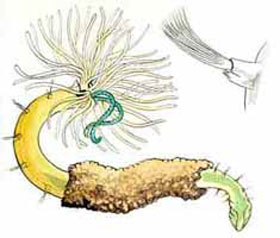 |
 |
|
Manayunkia baicalensis |
|
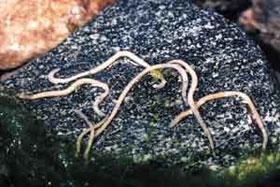
Mesenchytraeus bungei |
|
Multiseta worms (oligochaetes) are also numerous in Lake Baikal. Their palps are located in bunches – two from the sides of each segment except the mouth segment. Segments may vary in a number – between 5 and 600. Among benthic dwellers oligochaetes have the highest biomass, serve as food for fish and predatory invertebrates. Oligochaetes are spread from the water edge to maximal depths. They assist in purifying the lake. A small yellow oligochaete Mesenchytraeus bungei inhabits in abundance sand and stones of the coasts.
At the bottom of a stagnant water body there are a lot of worms crawling about. The most common is a sludge worm (Tubifex tubifex). According to its appearance, it looks like a small earthworm with setae all over the body. On the third segment, there is a thickening, the so-called “belt” containing a lot of mucous glands. During their reproduction, they form a cocoon out of mucus in which they lay eggs. Usually worms dig in black silt putting out their front body segment, which makes constant vibratory movements. Sludge worms are typical earth eaters: they simply swallow silt and digest everything which they find eatable in it. The amount of silt, which they infiltrate via their intestine per day, is 4-6 times more than their own body weight.
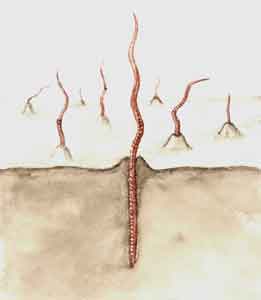
A colony of sludge worms at the bottom of a water body |

Sludge worm (Tubifex tubifex) |
Among plants and bottom sediments there are other annelid worms, e.g. Stylaria lacustris, with long setae and a process on the head lobe.
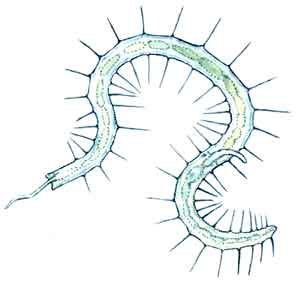
Stylaria lacustris |
Leeches (Hirudinea) differ in a flattened body. A snail leech prefers to sit on stones or to crawl slowly on them. In a resting state, it looks like a small wide leaf, while moving it can stretch. There is a small posterior sucker for attaching to the substratum. This species feeds mainly on snails and bivalve molluscs. The leech perforates soft covers of a prey with its resilient rostel and sucks its blood out. While reproducing, the leech lays out 3-8 cocoons with eggs, which are protected by its body. Hatched juveniles are attached to the leech’s belly and stay on it for about three weeks until they grow up.
Leeches Erpobdellaare are clearly seen from the shore because of their large size and ability to swim well curving their bodies. Unlike snail leeches, they do not have a rostel. With the powerful pharynx they swallow the whole prey or in parts. Leeches can feed on annelid worms, crustaceans, insect larvae, molluscs, as well as on fish fries. They can also feed on dead animals, and even on smaller individuals of their species.
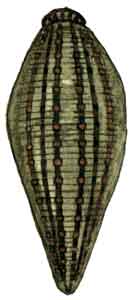
Snail leech |

Leech Erpobdellaare |
Copyright © 2005-2010 ЦНИТ ИГУ, 

Дизайн web-студия ЦНИТ ИГУ



